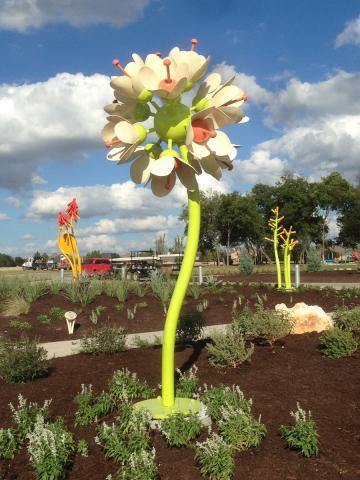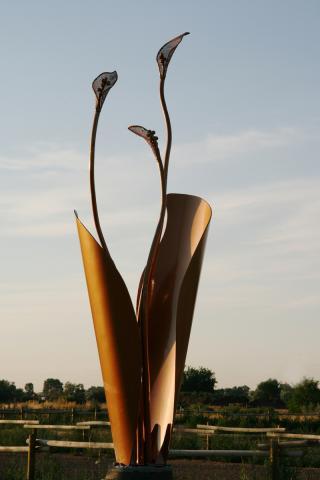DIPLOMA IN PAINTING, 1979
ALUMNI DISCOVERY INITIATIVE, INTERVIEW BY MARISSA GRUENKE, 2016

Milkweed, May + Watkins Design
Marissa GRUENKE: When did you graduate ACAD?
Tim WATKINS: I graduated ACAD in 1979. My major was painting; however, in my fourth year I became a sculptor. I was working on a piece that I was painting from a photograph, and I thought, why am I painting this? I should be making this as a sculpture! So I switched to sculpture.
GRUENKE: Did you graduate with a degree or a diploma?
WATKINS: I graduated with an honors diploma. I attended ACAD for four years, but I never did the academics. I preferred being in the studio and I have a diploma in fine arts.
GRUENKE: What is your current employment?
WATKINS: I am self-employed. My wife and I started a company, May + Watkins Design, that designs and builds public art and interpretive exhibits. She got me involved because it was a way to earn a living and make art. Also, it is a fun way of giving back to the world.
GRUENKE: A lot of graduates use the ACAD degree as a creative stepping stone. How has what you do evolved since graduation?
WATKINS: I always wanted my work to be publicly accessible. At ACAD, I was regularly exploring ways to move the work from the studio or gallery environment to public areas.
Post ACAD, at Skowhegan School of Painting & Sculpture, Lucy Lippard gave a lecture on public works (Robert Smithson, etc). I was so excited to see that artwork could live outside of the gallery system. I am happy to say that our work has progressed that way.

Pod + Bloom, May + Watkins Design
GRUENKE: How did your education at ACAD direct your career?
WATKINS: I was a bit of a black sheep, I went directly from high school into an honours zoology program. I quickly realized that university zoology did not interest me, and so I became a bit of a nomad and travelled Europe and Asia before returning to Calgary with the idea of teaching art for children. When I got to ACAD I felt like I was home. It was as challenging as I wanted to make it, and there was plenty of room to explore. I ended up using every department in my fourth year in my explorations of other mediums.
GRUENKE: What insights did your four years at ACAD give you?
WATKINS: ACAD offered me 4 years devoted to art making, but there is a lot more to an art career besides being in the studio. After ACAD, I met my future wife at the Skowhegan School of Painting and Sculpture in Maine, where I was able to focus on further developing my work. It was a nine-week summer program where seventy people are chosen to work in their studios. It was a good transition from ACAD since it was a step into the world of what being a ‘real’ artist was going to be like. It offered the opportunity to meet other artists, both peers and established visiting artists. My time at ACAD was great. I loved it.
GRUENKE: Why does what you learned at ACAD matter?
WATKINS: There were excellent instructors who helped me develop both studio and life skills. ACAD opened the door to this world.
GRUENKE: After graduation, what obstacles did you encounter and how did you overcome them?
WATKINS: The biggest obstacles are making a living and setting up a studio. I was very lucky because my wife lived in downtown Brooklyn (far different than what it is today), and she understood what was involved to get a studio there. I worked for a 'famous' artist for a couple of years. It was for very little money, but it was a huge experience in working with different materials and getting a glimpse of the New York art world. I learned that there are three things artists need to do to establish a career: make a living to pay the bills, spend time in the studio creating and developing their practice, and make contacts through showing. The latter was the biggest struggle for me since I would rather just be in the studio

Aerie & Mosaics, May + Watkins Design
GRUENKE: How could you imagine ACAD supporting our alumni?
WATKINS: I think it is interesting that I had next to no contact from an alumni association, until this interview. I feel that ACAD needs to pursue this connection further. Years ago, ACA/D had a lot of government support. It needs to find successful ways to reach out to the alumni. This seems like an excellent beginning as it connects the new students to some of the past students.
GRUENKE: What do you feel is the role of ACAD and our alumni in shaping our cultural and economic prosperity?
WATKINS: The arts are extremely important in the world, and they are not properly appreciated. A lot of people think of artists in a negative light, whether as freeloaders or crazies. In most cases that is not the true. ACAD should be finding a way to establish connections among their graduates and to the community through exhibits, public art, education, and performances. Just as the artists need to get their work out there, so should ACAD.
GRUENKE: Where does art fit into your future?
WATKINS: Art is my life. I hope to create art until the day I die. I am extremely lucky to be able to make a living from my art. To work on making art with my life partner is the icing on the cake.